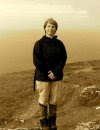To get to the cemeteries, one must walk quite a ways up the southern hill of the city. There are two gave yards, huge grave parks, really. One is for Christians and the other for Jews. The Christian cemetery is in full and present use. There was a funeral taking place as I passed by. The graves are decorated with flowers, lamps and pictures. Certain graves have benches installed in front of them so that mourners can commune. In front of one grave two women sat quietly weeping. At the crematory wall, another woman was freshening the flowers. At the gate going into the cemetery, there is a big sign in Czech and English: Beware Of Pickpockets. As near as I can tell, the method of a pickpocket is to bump up against you and in the extrication, take your stuff. If, in a quiet grave yard some one ran up to me and bumped into me that wo uld be beyond strange. Therefore, I must assume that "pickpocket" is a euphemism for "robber". It was scary to think of being set upon by robbers amidst the graves!
In the New Jewish cemetery, established in 1890, one finds many prominent Jewish writers and notables. They had to start this one because the one from the 1500s in the Jewish Ghetto was full. In the middle of he 20th century, Prague lost most of its Jewish population due to the Nazi Troubles. Kafka and his family are here. His three sisters have a plaque because they died in the camps. Anyway, this is more a memorial grave yard th aone in active participation like the one next door. The graves are covered with ivy, and there arena benches for relatives. There are, however, offerings of little pebbles and tiny trinkets left at the more notable graves and at the holocaust memorial sites. So there is, indeed, active mourning going on at this site, but it is more abstract and generalized than at the other graveyard.

Kafka's gravestone lists him and his parents with the plaque for his sisters leaned against the plinth. There is no icy on this grave, but a gravel "yard" around it. There are many little offerings of pebbles, beads, and fake flowers. I sat on a bench near the grave and watched a slow processions of pilgrims come by. They were all middle aged travelers in sensible shoes and quick-dry nylon pants, American and German. They came singly and silently. I watched five pass by. Each came down the path, stopped by the grave, and silently regarded it before turning and slowly walking away. None of these "mourners" made offerings, but, as a middle aged mourner in sensible shoes and quick-dry pants, I did leave a blue bead I found outside the hostel.

On the walk back, I walked down the street where Kafka lived when he wrote a few short stories. It borders a park, and the facades of the buildings do look like they must come from the turn of the previous century, it must have looked a lot like this when K was here. But more grey. In pictures I have seen from the turn of the 20th century, the buildings look a bit more worn and more air pollution stained than now when they have received a bit more friendly paint. Still I was entertained to think that this is what K saw as he walked on this street. It was nice, and it actually seemed quite a posh place to live in the early 21st century.
The contrast of the old town and the new town was interesting to see because of the contrast of bustling tourism and quiet residence. Will this inform my readings? Well, downtown is more closed in and the pressure seems greater. Getting out into the residential area did seem more relaxed.



No comments:
Post a Comment